Judi Lynn
Judi Lynn's JournalThe martyred Jesuit who converted San Romero
written by Gianni Beretta
Published on
January 28, 2022
On Sunday, in San Salvador, a ceremony was held for the beatification of the Jesuit Rutilio Grande, the first priest to be killed in El Salvador in March 1977 by the Guardia Nacional at the behest of the landowners, who called him “a communist on the side of the campesinos.” Together with him, in the ambush that took place in the rural area of Aguilares, an elderly farmer and a 15-year-old boy were also shot dead in the same car. They, too, were now declared “blessed,” along with the Franciscan missionary of Italian origin, Cosma Pessotto, who was killed in a church in June 1980, when the civil war had already begun.
The ceremony, presided over by Salvadoran Cardinal Rosa Chavez, was not attended by the young President Najib Bukele, who just a week earlier had also provocatively canceled the commemoration of the 30th anniversary of the peace agreements that put an end to the bloody conflict between the civilian-military regime and the guerrillas. Bukele preferred to leave for Ankara, where he is set to sign an unprecedented trade agreement with his Turkish counterpart Erdogan.
In the 1970s and 1980s, a heavy toll of blood was paid by that part of the Salvadoran Church that was influenced by the Teología de la Liberación: 20 priests (including the six Jesuits of the Central American University), four nuns and hundreds of catechists from an eminently Catholic people all lost their lives.
It culminated in the murder on March 24, 1980 of the Archbishop of San Salvador, Oscar Romero, while he was saying mass. And yet, he had been initially proposed to the Vatican as candidate for metropolitan by his reactionary fellow bishops, being a conservative himself, with the aim of perpetuating the age-old colonial scheme of an oligarchy with its two operational arms, military and ecclesiastical.
More:
https://global.ilmanifesto.it/the-martyred-jesuit-who-converted-san-romero/
Fire Expert Refuted Government Claim That 43 Disappeared Students Were Incinerated at Infamous Dump
Washington, DC, January 28, 2022 – National Security Archive continues the "After Ayotzinapa" project by publishing today the José Torero Cullen interview.
“After Ayotzinapa” is the result of a two-year collaboration between the National Security Archive and Reveal News from the Center for Investigative Reporting. Reported and co-produced by National Security Archive senior analyst Kate Doyle and Reveal senior reporter Anayansi Diaz-Cortes, the three-part serial reveals the story of what happened in the months and years following the forced disappearance of 43 college students in the state of Guerrero, Mexico on September 26, 2014. Part One: The Missing 43, aired on January 15. It describes the actual attack on the students. Part Two: Cover-Up, aired on January 22. It details the botched initial investigation and exposure of government obstruction. Part Three: All Souls, airing on January 29, addresses the efforts being made by a new government to overcome the cover-up and truly advance the cause of truth and justice for the missing 43 students. There are three ways to listen: on your podcast app of choice: Apple Podcasts, Spotify, Stitcher; on Reveal’s website, and on radio stations around the United States.
~ ~ ~
The interview
José arrived in Mexico City from Australia, where right away he was confronted by “a level of stress and tension among all the people involved” that he had never faced before.
I was brought immediately to see some evidence by the lawyers, to meet the Argentinian forensic team who had photographs and information of all the work that they had been doing for a long period of time. And the next morning, we go directly to La Procuraduría General de la República (PGR–Mexico’s justice department) and we get put in a helicopter. It's such an unusual context for somebody like me who basically works on technical matters. We arrive in Guerrero, we jump into armored cars, people are carrying weapons, and you're being driven into this dump.
I'm an academic. My regular day is: I go to work, I interact with students, I teach classes, I do my research. I do the occasional investigation that forces me to go to the field. But taking a car to a senior government office, going to the roof, catching a helicopter, flying in a helicopter and then landing in a soccer field surrounded by military cars and people with automatic weapons, and being literally escorted into a car... I mean, that's more James Bond film than the type of environment in which someone like me is used to working.
We asked José: Can you describe the dump and what you found there that contributed to your conclusions?
You have to descend maybe 150, 200 yards down into this hole, and the path that you're descending is incredibly steep, but also it’s not a path of soil, it is a path of garbage. So you have enormous amounts of garbage, plastic bottles, bags, you name it - insects all over the place, your legs are being eaten alive - and you have to walk through this garbage until you get to the bottom. [...] The whole bottom part of the dump had already been cleared, it had already been studied, a number of people had already collected a massive amount of evidence. [But] that's not really what I went to see.
If you're thinking about incinerating a very large number of bodies, what you're going to be needing is a very large fire. Now, a very large fire radiates an enormous amount of heat. And that enormous amount of heat, for example, when in proximity of plastic bottles will melt those plastic bottles and shrivel them and most likely actually ignite them. So you would have had significant evidence of fire-spread on the slope. So the slope would have been filled with burnt material. [...] What I did was a mapping of radiation. And I basically showed that as you moved away from the place where the fire was meant to be, you would have expected ignition of this garbage. You would have expected charring of the trees. You would have expected melting. So in principle, that slope would have had massive amounts of damage.
Now, instead, if you correlate the images that were taken days after the apparent incineration of these bodies, you will see that the same bottles - I managed to identify the same bottles that were in images taken months before - were still there! And they were completely undamaged. They were completely unaltered, and it was exactly the same pieces of garbage that could be identified. So the slope was, one, not altered, and two, had not been affected by radiation. So the unavoidable conclusion is that there could have not been a big fire in that dump.
More:
https://nsarchive.gwu.edu/news/mexico/2022-01-28/fire-expert-refuted-government-claim-43-disappeared-students-were
Honduran president's fall from grace poised to end in US indictment
As his term ends, Juan Orlando Hernández could be extradited on drug charges to the country that once saw him as a key ally
Jeff Ernst in Gracias, Honduras
Wed 26 Jan 2022 05.30 EST
Along a paved road that climbs the hillside to Celaque Mountain national park in south-western Honduras, one-room shacks are overshadowed by high-walled mansions – including the homes of President Juan Orlando Hernández and his political allies.
Local people say the results of Hernández’s eight years as president are on full display.
“He worked hard for his own good – not for the good of the people,” said Jesús Martínez, 68, a farmer resting in the picturesque colonial park in the center of Gracias.
“The people continue in calamity, and he’s leaving as a millionaire.”
More:
https://www.theguardian.com/world/2022/jan/26/honduras-juan-orlando-hernandez-president
Journalist Interviewed Survivors of the Attack on the Ayotzinapa Students
and is Featured in Episode 1 of the Podcast
Episode 2 Comes Out Tomorrow, January 22
Washington, DC, January 21, 2022 – John Gibler is a journalist, author, and activist who writes eloquently and prolifically about Mexico. His collection of testimonies from Ayotzinapa students who survived the tragedy of September 26, 2014 – which he published as a book, I Couldn’t Even Imagine That They Would Kill Us: An Oral History of the Attacks Against the Students of Ayotzinapa (City Lights, 2017) – became and remains the most definitive account of those terrible events from the young men who lived through them.
In Episode 1 of the podcast, John describes being home in Mexico City when he reads about the missing students and decides to pack a bag and go to the teacher training school to investigate. John gave Anayansi Diaz-Cortes and me access to his recordings of students from those early days after the attacks, and once we got permission from the two men featured in the podcast – Nico and Lalo – we were able to include their voices.
On January 19, John and I met on Zoom to talk about his experience reporting on the case in those early days, and his analysis of how government authorities and organized crime colluded to produce one of Mexico’s most shocking human rights atrocities. What follows is a condensed and edited version of our conversation.
--Kate Doyle
liThe interview
Doyle: Tell me about your decision to go to Guerrero after hearing about the attacks.
Gibler: I really had no idea of writing a book or writing a certain kind of article. I went there thinking, what happened? And because there was so much confusion in the media, there was so much disinformation on behalf of authorities, and the scale of events was so overwhelming, there hadn't been yet just a simple reconstruction of events, a journalistic reconstruction. So my initial objective was, ok, let's just document the events of that night. Let's just find out what happened.
More:
https://nsarchive.gwu.edu/news/mexico/2022-01-21/kate-doyle-interviews-journalist-john-gibler-ahead-episode-2-release-after?eType=EmailBlastContent&eId=6551e0c8-6418-469b-b6f8-6f38a1b47136
~ ~ ~
Excerpt frome one ne of the linked articles offered at this site:
“After Ayotzinapa” Podcast Investigates Horrific Mexican Atrocity
THE “NIGHT OF IGUALA”
On September 26, 2014, police attacked a group of college students as they rode on buses through the town of Iguala in southwestern Mexico; they blocked the buses from moving forward, then they opened fire. For hours, federal security forces and soldiers from a nearby base circulated in and around the chaotic scenes of violence, but never stopped to intervene. The long, harrowing night left six people dead. The police detained 43 of the students and piled them into the backs of their trucks. The young men were never seen again.
The victims were students from a rural teacher-training school called Ayotzinapa, located in an impoverished region in Mexico’s Guerrero state. Although they were attacked in the center of a bustling municipality, taken by local police, and then handed off to drug traffickers – all under the watchful eye of dozens of federal police and military – the government failed to find them, identify who ordered their kidnapping, or explain why they were targeted. Worse, it became clear that President Enrique Peña Nieto's hand-picked investigator, Tomás Zerón, actively obstructed the investigation, destroyed and fabricated evidence, tortured detainees to confess to outlandish versions of what happened, and promoted a false narrative about the crime.
The disappearance of the 43 became a notorious symbol of state-sponsored criminality and impunity, confirming Mexicans’ worst fears that their government was irreversibly brutal and corrupt—at every level.
VOICES IN THE PURSUIT OF JUSTICE
Reported and co-produced by National Security Archive senior analyst Kate Doyle and Reveal senior reporter Anayansi Diaz-Cortes, “After Ayotzinapa” reveals the story of what happened in the months and years following that terrible “night of Iguala.” Its focus is not the crime but the investigation: the false starts, the red herrings, the government’s incoherent narrative, and its attacks on the families and human rights investigators. The final episode addresses the efforts being made by a new government to overcome the cover-up and truly advance the cause of truth and justice for the missing 43 students.
More:
https://nsarchive.gwu.edu/news/mexico/2022-01-10/after-ayotzinapa-podcast-investigates-horrific-mexican-atrocity
~ ~ ~
A short news report made a year after the atrocity:
The Search Continues: Mexico's Disappeared Students (Part 2)
An Uncertain Fate: Mexico's Disappeared Students (Part 3)
(Much more information than has been available through corporate media. Very helpful.)
Book Review: Mario Vargas Llosa Takes On a Coup in Guatemala
BY NICK BURNS
JANUARY 12, 2022
The Peruvian novelist brings Central America’s bloody Cold War past to life – with a surprising political angle.

Jacobo Árbenz Guzmán, after being ousted in a coup, speaks with reporters in Paris in 1955.
Bettmann/Getty Images
One of the most sinister episodes in the history of U.S. entanglement in Latin America forms the subject of Mario Vargas Llosa’s latest novel, Harsh Times. The scene is Guatemala during the first decade of the Cold War when, as U.S. fears of Soviet influence ramped up, President Jacobo Árbenz’s plan for land reform worried the powerful, U.S.-run United Fruit Company.
Vargas Llosa describes what happened next in a narrative that draws both on historical records and his own imagination. United Fruit concluded that Árbenz was not a communist, but that his program would damage their interests in the country, which had been favored by previous military rulers. So they devised a campaign to persuade the U.S. government of something they believed not to be true: that Árbenz represented a communist threat in the American hemisphere.
“The danger, gentlemen, lies in setting a bad example. Not so much communism as democracy in Guatemala.” So Vargas Llosa imagines the plan might have been described by Edward L. Bernays, the “father of public relations” and a key figure in the United Fruit–sponsored propaganda campaign against Árbenz.
The campaign was largely successful, and the CIA went on to carry out Operation PBSuccess, supporting an invasion of the country in 1954 led by Carlos Castillo Armas. The invasion toppled Árbenz’s government and ushered in a chaotic period of violence and anticommunist purges.
More:
https://americasquarterly.org/article/book-review-mario-vargas-llosa-takes-on-a-coup-in-guatemala/
Cuba Slams 20 Years of U.S. 'Occupation,' 'Abuses' at Guantanamo Bay, U.N. Calls for Closure
BY TOM O'CONNOR ON 1/11/22 AT 6:27 PM EST
Cuba officials have slammed the ongoing U.S. military presence on the shores of Guantanamo on the 20th anniversary of the opening of a controversial detainment facility there that U.N. experts and other analysts want shuttered immediately.
The prison was the target of a report published Monday featuring the opinions of a group of experts appointed by the U.N. Human Rights Council, which President Joe Biden's administration has re-engaged with as of last February. The voices featured were unanimous in their censure of the facility and seeking its closure.
"Despite forceful, repeated and unequivocal condemnation of the operation of this horrific detention and prison complex with its associated trial processes, the United States continues to detain persons many of whom have never been charged with any crime," the experts said.
They went on to describe the site as one "of unparalleled notoriety, defined by the systematic use of torture, and other cruel, inhuman or degrading treatment against hundreds of men brought to the site and deprived of their most fundamental rights."
More:
https://www.newsweek.com/cuba-slams-20-years-us-occupation-abuses-guantanamo-bay-un-calls-closure-1668249?piano_t=1
Iniskim Umaapi: Is this Canada's 'Stonehenge'?
(Image credit: Greg Olsen)
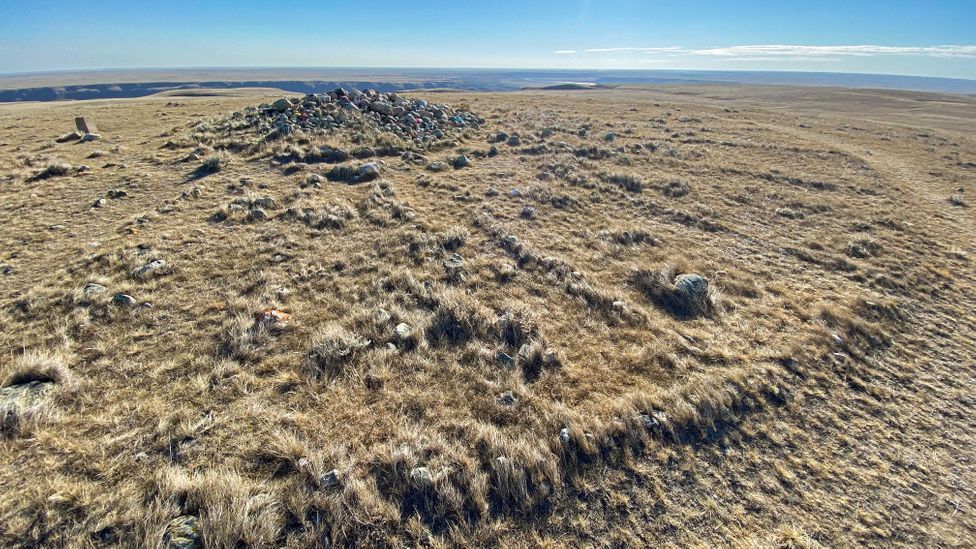
By Debbie Olsen
10th January 2022
Built by ancient Indigenous People and long considered to be sacred, the Iniskim Umaapi medicine wheel in Alberta is one of the oldest religious monuments in the world.
About a year into the Covid-19 pandemic, Laura Sitting Eagle was feeling unwell. The Blackfoot Elder, who resides on Siksika 146 – a First Nations reserve of the Siksika Nation in southern Alberta, 87km south-east of Calgary – went to see her doctor and was informed that anxiety was the issue. With a daughter working as a frontline healthcare worker and a school vice-principal son, she was worried for the health of her family and the stress was affecting her own wellbeing. She realised that she needed to get emotional, spiritual, physical and mental balance.
As her ancestors before her had done, she found relief in making a trek to the medicine wheel called Iniskim Umaapi to pray and make a spiritual offering.
One of the oldest religious monuments in the world, the medicine wheel sits on a windswept hill far from any signs of civilisation. It consists of a central cairn surrounded by 28 radiating stone lines that are encircled by another large ring of stones measuring 27m in diameter. The Blackfoot have many names for it, but the current commonly accepted name is Iniskim Umaapi, which means "buffalo calling stones sacred site". European colonists named the stone circle Majorville Medicine Wheel, after the Majorville post office and general store that was once nearby. Settlers called these structures medicine wheels because they resemble wagon wheels and are considered sacred sites by Indigenous People. Regardless of their name, these enigmatic geoglyphs are shrouded in mystery – Iniskim Umaapi more so than any others.
Medicine wheels are scattered across the Northern Plains, in Montana, Wyoming, Saskatchewan and Alberta, but Iniskim Umaapi is the oldest-known one in the world. Archaeological studies estimate the ancient stone circle to be about 5,000 years old – dating roughly the same time as the first phase of construction of Stonehenge. Located on England's Salisbury Plain, Stonehenge is thousands of kilometres and an ocean apart from Iniskim Umaapi. The fact that both stone circles are ancient and have mysterious purposes and origins led to Iniskim Umaapi being dubbed "Canada's Stonehenge" by Gordon R Freeman, professor emeritus at the University of Alberta.
More:
https://www.bbc.com/travel/article/20220109-iniskim-umaapi-is-this-canadas-stonehenge
Bolivia busts alleged US arms shipment heading to right-wing forces
SUNDAY, JANUARY 9, 2022
BOLIVIA has seized arms which were allegedly sent by the United States to arm opposition forces in the Santa Cruz region of the country, state forces claimed today. The shipment contained a batch of automatic, semi-automatic and other high-calibre weapons, according to the Special Force to Fight Crime director Limbert Coca.
The deadly cargo was discovered after customs officials became suspicious and ordered “a physical and documentary verification.” They found that the arms cache and other materials camouflaged and hidden away under empty boxes and clothing, Mr Coca explained.
. . .
Santa Cruz is led by far-right governor Luis Fernando Camacho who is an open supporter of the 2019 Washington-backed coup that ousted former president Evo Morales.
. . .
Scores of indigenous Bolivians were killed in the Senkata and Sacaba massacres when interim president Jeanine Anez mobilised the armed forces to put down protests.
More:
https://morningstaronline.co.uk/article/w/bolivia-busts-alleged-us-arms-shipment-heading-right-wing-forces-bolivia
Luis Fernando Camacho
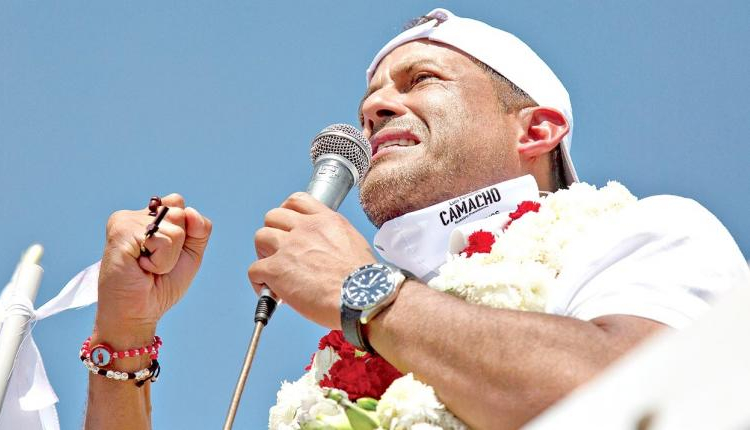
Racist, fascist Governor Luis Fernando Camacho
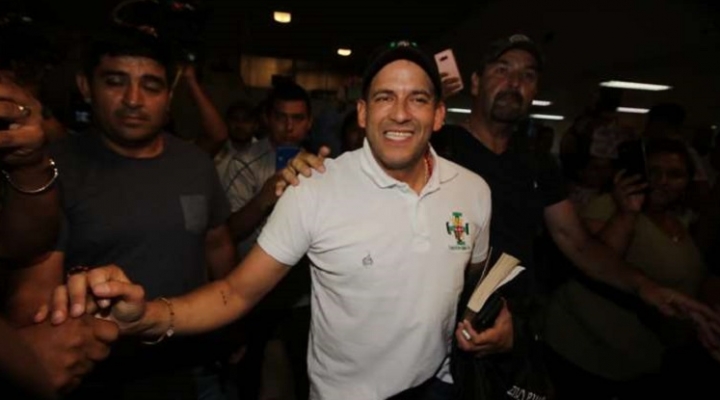
Dipstick Gov. has his Bible with him.

Union Juvenil Cruceñista Bolivia fascistsMembers of Bolivia's extreme-right Santa Cruz Youth Union (Unión Juvenil Cruceñista, or UJC), and Luis Fernando Camacho (on right)
Bolivian coup officials and supporters stalk international election observers, launch violent incitement campaign
By the time a team of electoral observers arrived in Bolivia – including members of The Grayzone – right-wingers had already published a flood of online threats, smearing them as “terrorists” and circulating photos captured while stalking them in the airport.
By Ben Norton
SANTA CRUZ, BOLIVIA – Contributors to The Grayzone including Max Blumenthal, Anya Parampil, and Ben Norton traveled from the United States to Bolivia in order to join a delegation of independent international observers of the country’s October 18th presidential election – the first vote since a November 2019 US-backed military coup removed the country’s elected president.
Little known to us, however, was that we were being stalked on the way. A number of Bolivians covertly took photos of us as we waited for a connecting flight in the airport in Chile, snapped more as we boarded the plane, and published the images on social media, along with our personal information and a flight itinerary showing when we would arrive to Bolivia. The incitement campaign has led to a wave of physical threats and calls for harassment.
. . .
Hours after photographs of us were published on social media, Murillo issued a thinly veiled threat. “Our elections will be a democratic celebration, the more observers there are, the better for everyone. We warn agitators and people who seek to generate violence, they are not welcome. We will put them on a plane or behind bars. Behave, we know who you are and where you are.”
. . .
Camacho was the leader of a powerful right-wing group called the Pro-Santa Cruz Civic Committee, which was co-founded by Croatian Nazi collaborators who fled to Bolivia after WWII, and whose young followers are infamous for fascist-style salutes and anti-indigenous violence.
More:
https://thegrayzone.com/2020/10/15/bolivia-stalk-threat-election-observers/
Amy Goodman of "Democracy Now" discussing the Bolivian coup during Trump's "presidency" below.

Youth Union thugs conducting another assault upon indigenous Bolivians to keep their terrorism fresh. Indigenous
people are the majority in Bolivia, of course, although they weren't allowed to vote, even, until after a revolution in
1952, nor even walk upon the sidewalks.





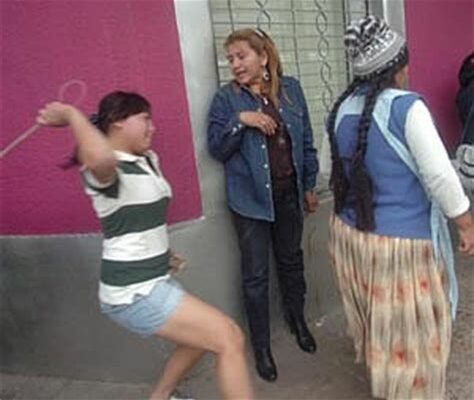

Youth Union terrorists put their clubs on the ground and lowered their heads for a moment of prayer.

Another display of their white "Christian" piety through public praying.
Machu Picchu's Stairway of Fountains
Only just saw this for the first time:
By JULIAN SMITH
January/February 2013
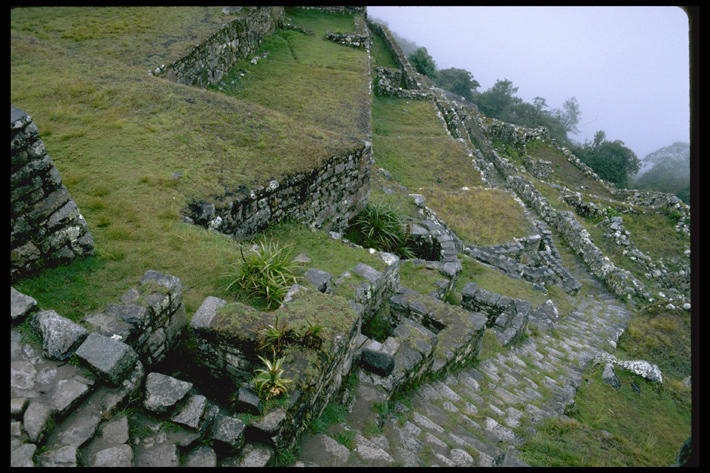
(Courtesy Tamara L. Bray)The square chambers next to a staircase at the Inca city of Machu Picchu are part
of an ingenious network of 16 fountains.
One of the most spectacular examples of Inca hydraulic engineering is the "Stairway of Fountains," built sometime after 1450 at the city of Machu Picchu. The fountains supplied the city's inhabitants with clean, fresh water. The first challenge the Inca faced was how to bring water from a pair of rain-fed springs almost half a mile away from the first fountain. At the main spring, Inca engineers built a 48-foot long permeable wall that concentrated the seeping water into a stone-lined canal. The canal also collected water from a second, smaller spring. Water flowed to the city through the canal, which averaged five inches wide and five inches deep, and had an average grade of about 3 percent. Hydraulic engineer Ken Wright calculates the system could carry up to 80 gallons per minute—twice as much water as the springs' typical peak flow—to prevent overflows.
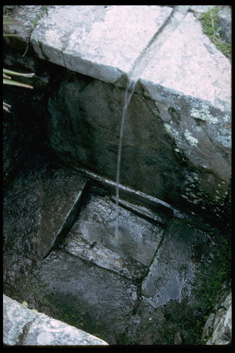
(Courtesy Tamara L. Bray) Each
fountain produced a stream of water
shaped to fill a water jug.
The canal passed under the city's outer wall, through the agricultural zone, and under another wall into the residential zone, where it flowed through a series of 16 fountains. Each fountain had a spout designed to shape a jet of water that was the perfect size for filling an aryballo, the clay water jug of the ancient Andes. The fountains were linked by stone channels that formed a 180-foot-long cascade of water with a total vertical drop of 65 feet. The first fountain was next to the emperor Pachacuti's residence, allowing him first access to the water. All the fountains, including Pachacuti's, were publicly accessible except the last one, which was located inside the Temple of the Condor.
The result was a controlled, dependable public water supply that protected the hillside architecture from erosion. "Nothing like it exists," says hydraulic engineer Charles Ortloff, "in an urban setting at other royal residence sites or at other Inca settlements."
https://www.archaeology.org/issues/59-1301/76-sidebars/394-machu-picchu-inca-hydraulic-engineering
~ ~ ~
The Water Temple of Inca-Caranqui
Hydraulic engineering was the key to winning the hearts and minds of a conquered people
By JULIAN SMITH
January/February 2013
Tamara Bray of Wayne State University walks through a municipal lot in a suburb of the colonial city of Ibarra, in the Andean highlands of northern Ecuador. At 7,550 feet on the northern slope of Imbabura Volcano, the equatorial sun has an intensity that burns through the occasional cool breeze. Chickens peck in the dirt and we can hear children playing at a school nearby. As we walk through the lot, which is now an archaeological site called Inca-Caranqui, Bray explains that the local people knew this was an ancient settlement long before the first archaeological surveys in the late 1990s. Just across the street stand two walls—one 130 feet long and the other 165—that were built by the Inca. One wall has traces of three trapezoidal doorways with remnants of plaster and pigments.
Ecuadorian archaeologist José Echeverría leads us through the site, down a winding path that follows the low outlines of partially excavated walls. He explains that, in 2006, he was helping clear debris left over from a brickmaking operation when he uncovered some Inca masonry at the east end of the site, which turned out to be part of a large ceremonial pool about 33 by 55 feet in size. It was dug to a depth of four to five feet below the modern ground level and was surrounded by walls about three feet high. The walls and floor were made of finely cut and fitted stone.
Bray and Echeverría believe the pool may date to a period in the early 1500s, shortly after the Inca ruler Huayna Capac had concluded a 10-year war of conquest against the local people, the Caranqui. Legend has it that Huayna Capac had every adult male Caranqui executed. Their bodies were thrown into a lake known today as Yahuarcocha, or the “Lake of Blood,” on Ibarra’s northeast edge. Spanish chronicler Pedro Cieza de León estimated the conflict left 20,000 to 50,000 Caranqui dead.
Bray and Echeverría think that in the aftermath of that bloodshed, the Inca built the pool as part of a construction project that was meant to demonstrate their power to their new Caranqui subjects. The ceremonial pool would have represented a considerable investment of wealth and labor by the Inca. It also would have showed their skill as engineers by bringing water from as far as five and a half miles away and demonstrated their mastery over a resource with powerful religious symbolism.
More:
https://www.archaeology.org/issues/59-1301/61-features/324-ibarra-andes-huayna-capac-atahualpa
Cuba's vaccine success story sails past mark set by rich world's Covid efforts
Ed Augustin in Havana
Wed 5 Jan 2022 05.00 EST
General Máximo Gómez, a key figure in Cuba’s 19th-century wars of independence against Spain once said: “Cubans either don’t meet the mark – or go way past it.”
A century and a half later, the aphorism rings true. This downtrodden island struggles to keep the lights on, but has now vaccinated more of its citizens against Covid-19 than any of the world’s major nations.
More than 90% of the population has been vaccinated with at least one dose of Cuba’s homegrown vaccines, while 83% have been fully inoculated. Of countries with populations of over a million, only the United Arab Emirates has a stronger vaccination record.
“Cuba is a victim of magical realism,” said John Kirk, professor emeritus of Latin American studies at Dalhousie University, Canada. “The idea that Cuba, with only 11 million people, and limited income, could be a biotech power, might be incomprehensible for someone working at Pfizer, but for Cuba it is possible.”
More:
https://www.theguardian.com/world/2022/jan/05/cuba-coronavirus-covid-vaccines-success-story
Profile Information
Member since: 2002Number of posts: 160,515